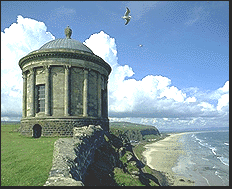 Exploring
Derry
Exploring
Derry
Original Official Site of the Northern Ireland Tourist Board

Mussenden Temple
Three miles north of Derry (take A2) is the Earhart Centre at Ballyarnet. The first woman to fly the Atlantic solo, Amelia Earhart, brought her plane down here in 1932. Hilltop Open Farm nearby specialises in rare breeds of pigs and sheep.
South are the rolling Sperrin Mountains with their forests and river glens. To the east and north-east are wide Lough Foyle, Magilligan Strand (Ireland's longest beach) and the lovely and fascinating Roe Valley Country Park. West and north lies rugged County Donegal.
All these areas provide marvellous fishing. For the motorist or walker they provide endless variety.
The shortest route to the Sperrins is up the pleasant valley of the river Faughan. The route passes Ness Wood, where the Burntollet river plunges 30 feet over Ulster's highest waterfall. Nature trails wind among the trees: oak, ash, birch, pine, silver fir, holly, hazel, willow, alder, rowan, rhododendron.
A mile from the Ness is Loughermore Forest, which has a caravan site amid wild scenery.
The head of the Faughan valley is at Learmount Forest, popular for walks. Close by soars Sawel (2,240ft) highest mountain in the Sperrins. There are valleys with streams on every side.
Near Claudy, Cumber House Riverside Park is a 22-acre picnic area and nature reserve on the banks of the Faughan, and there are seven acres of riverside parkland at Ardmore.
Seaside and Villages
Heading east towards Limavady is a fertile plain, reclaimed by dykes from Lough Foyle, with villages and small towns established in the 17th century by the City of London guilds.
Eglinton (established by the Grocers' Company) still has an English air about it, with elegant church, former market house, trees around a green and two oaks which started life in Windsor Great Park. South of the village is Muff Glen with walks and bridges over its little rushing stream. Birdwatchers should see the glen and then walk along the top of the embankment of Lough Foyle where the mud flats at low tide are feeding grounds for seabirds and waders.
The shore sweeps out to Magilligan Point, where the shingle becomes pure sand, rounding the point and forming the famous six-mile Atlantic beach. A massive Martello tower stands at the point: and at the far eastern end of the strand, on a clifftop, is another circular edifice - the Mussenden Temple, a perfect replica of the Roman temple of Vesta. A few decades before the menace of Napoleon brought Magilligan's Martello tower into existence, Frederick Augustus Hervey, wealthy Bishop of Derry and Earl of Bristol, built a palace on a windswept headland at Downhill. Today the palace is in ruins but his library, the Mussenden Temple, is still intact.
Despite his extravagances, Hervey was a good bishop. The mountain road he built to Limavady gave work to the local people. The road runs across Binevenagh plateau, with splendid views of the Scottish coast and Donegal.
Magnificent Benone Strand won the European Blue Flag award. Hundreds of yards wide at low tide with thundering Atlantic breakers, it is popular for shore fishing, particularly bass. You can sometimes see sailplanes and hang gliders from the viewpoint on the Bishop's road.
Inland from Magilligan is the village of Ballykelly, close by the old town of Limavady. Ballykelly was founded by the London Fishmongers' Company and old Walworth House retains three stocky towers and part of its defensive bawn wall.
The Sampson Tower in Farlow Wood, one mile west of Limavady, is an intriguing Gothic-style memorial erected in 1860 to Arthur Sampson, agent for the Fishmongers' Company.
Limavady was founded in Elizabethan times. It is one of Ulster's most characteristically Georgian towns. It was here that Jane Ross noted down the famous Londonderry Air ('Danny Boy') from a passing fiddler. But its great charm for the tourist is the Roe Valley Country Park. The river Roe winds through gorges where the rapids turned the waterwheels of several mills. The mills and a 19th-century hydro-electric plant have been restored, and the weaving shed houses a museum. The park has a modern visitor centre and a camping and caravan park. The 18-hole Roe Park golf course is on the western outskirts of the town.
The Iron Age fort known as the Grianan of Aileach is seven miles north west of Derry, in County Donegal. For centuries the seat of the O'Neills, high kings of Ulster, it has panoramic views over Lough Swilly.
County Londonderry Overview | Exploring Derry | History of Derry | Sperrin Mountains
Northern Ireland Homepage | Travel Tips | Golf | Industrial Heritage | Walking, Hiking & Horseback | Activities | Calendar of Events | Transportation | Cuisine and Restaurants | Birdwatching | Fishing | Ancestral Heritage | County Antrim | County Armagh | City of Belfast | County Down | County Fermanagh | County Londonderry | County Tyrone | Tour Operators | InterKnowledge Home Page
Copyright (c) 1995-1997 interKnowledge Corp. All rights reserved.
